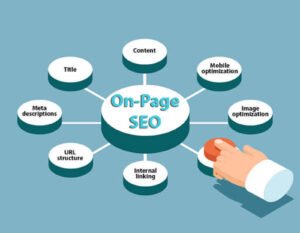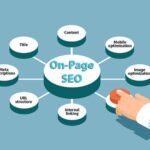What is On-Page SEO?
On-page SEO (Search Engine Optimization) refers to the practice of optimizing individual web pages to rank higher on search engine results pages (SERPs) and drive organic traffic. It involves refining elements directly on the webpage, such as content, HTML, and structure, to make it more relevant and accessible to search engines and users. Unlike off-page SEO, which focuses on external factors like backlinks, on-page SEO is entirely within the website owner’s control.
Key Elements of On-Page SEO
1. High-Quality Content
-
Keyword Research: Identify relevant keywords with tools like Google Keyword Planner, Ahrefs, or SEMrush. Target primary keywords and long-tail variations that align with user intent.
-
Content Relevance: Create valuable, engaging, and informative content that addresses the needs of your audience. Answer their questions and solve their problems.
-
Keyword Placement: Naturally incorporate keywords in the title, headings, first paragraph, and throughout the content without overstuffing.
-
Content Length: While there’s no strict rule, longer content (1,500–2,000 words) often performs better for in-depth topics, provided it remains high-quality and relevant.
2. Title Tags
-
Definition: The title tag is an HTML element that defines the title of a webpage, displayed on SERPs and browser tabs.
-
Best Practices:
-
Keep titles under 60 characters to avoid truncation.
-
Include the primary keyword near the beginning.
-
Make it compelling to encourage clicks (e.g., “The Ultimate Guide to On-Page SEO in 2025”).
-
Ensure each page has a unique title.
-
3. Meta Descriptions
-
Definition: A meta description is a brief summary (160–170 characters) of a page’s content, appearing below the title on SERPs.
-
Best Practices:
-
Include the primary keyword and a call-to-action (e.g., “Learn more” or “Discover how”).
-
Write engaging descriptions to boost click-through rates.
-
Avoid duplicate meta descriptions across pages.
-
4. Header Tags (H1, H2, H3)
-
Definition: Header tags organize content hierarchically, improving readability and SEO.
-
Best Practices:
-
Use one H1 tag per page, typically for the main title.
-
Incorporate keywords in H1 and H2 tags naturally.
-
Use H2 and H3 tags to break up content into scannable sections.
-
5. URL Structure
-
Definition: URLs should be descriptive, short, and optimized for search engines.
-
Best Practices:
-
Include the primary keyword (e.g., example.com/on-page-seo-guide).
-
Keep URLs concise and avoid unnecessary parameters.
-
Use hyphens (-) instead of underscores (_).
-
Ensure URLs are lowercase and consistent.
-
6. Image Optimization
-
Definition: Optimizing images improves page load speed and user experience.
-
Best Practices:
-
Use descriptive file names (e.g., on-page-seo-checklist.jpg).
-
Add alt text with relevant keywords for accessibility and SEO.
-
Compress images to reduce file size without sacrificing quality (tools like TinyPNG or ImageOptim).
-
Use appropriate image formats (e.g., JPEG for photos, PNG for graphics).
-
7. Internal and External Linking
-
Internal Links: Link to other relevant pages on your site to improve navigation, distribute page authority, and keep users engaged.
-
External Links: Link to authoritative, high-quality websites to provide additional value and signal credibility to search engines.
-
Best Practices:
-
Use descriptive anchor text.
-
Avoid excessive linking, which can dilute authority.
-
Ensure all links are functional (no broken links).
-
8. Mobile Optimization
-
Definition: With Google’s mobile-first indexing, pages must be optimized for mobile devices.
-
Best Practices:
-
Use responsive design to ensure compatibility across devices.
-
Test mobile usability with Google’s Mobile-Friendly Test tool.
-
Optimize for touch navigation and fast loading on mobile.
-
9. Page Load Speed
-
Definition: Faster pages improve user experience and SEO rankings.
-
Best Practices:
-
Minimize CSS, JavaScript, and HTML with tools like Minify.
-
Enable browser caching and use a Content Delivery Network (CDN).
-
Optimize images and reduce server response time.
-
Use tools like Google PageSpeed Insights or GTmetrix to identify issues.
-
10. Schema Markup
-
Definition: Schema markup is structured data that helps search engines understand page content, enabling rich snippets in SERPs.
-
Best Practices:
-
Use schema types like Article, Product, or FAQ to enhance visibility.
-
Implement markup with JSON-LD format for simplicity.
-
Test with Google’s Structured Data Testing Tool.
-
Why On-Page SEO Matters
On-page SEO directly impacts how search engines interpret and rank your content. By optimizing these elements, you:
-
Improve relevance for target keywords.
-
Enhance user experience, reducing bounce rates.
-
Increase the likelihood of ranking for featured snippets or rich results.
-
Build a foundation for off-page SEO efforts, like link building.
Common On-Page SEO Mistakes to Avoid
-
Keyword Stuffing: Overusing keywords makes content unnatural and can lead to penalties.
-
Thin Content: Pages with low-quality or minimal content rank poorly.
-
Duplicate Content: Identical content across pages confuses search engines.
-
Neglecting User Intent: Content that doesn’t align with what users are searching for will underperform.
-
Ignoring Technical Issues: Broken links, slow load times, or non-optimized images harm rankings.
Tools for On-Page SEO
-
Google Search Console: Monitor indexing, errors, and performance.
-
Yoast SEO or Rank Math: WordPress plugins for optimizing content.
-
Screaming Frog: Crawl websites to identify on-page issues.
-
Ahrefs or SEMrush: Conduct keyword research and competitor analysis.
-
Google Analytics: Track user behavior and traffic sources.





